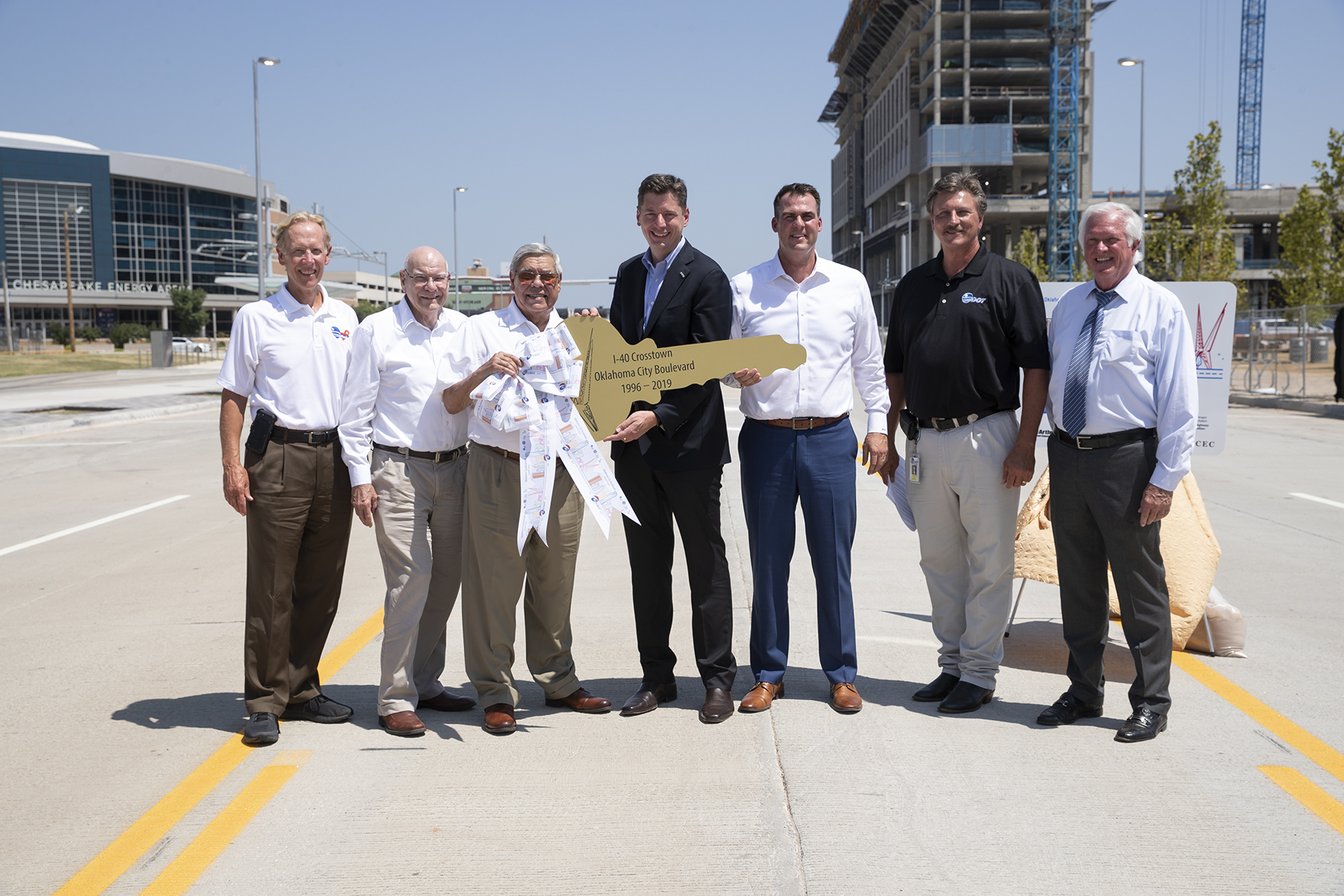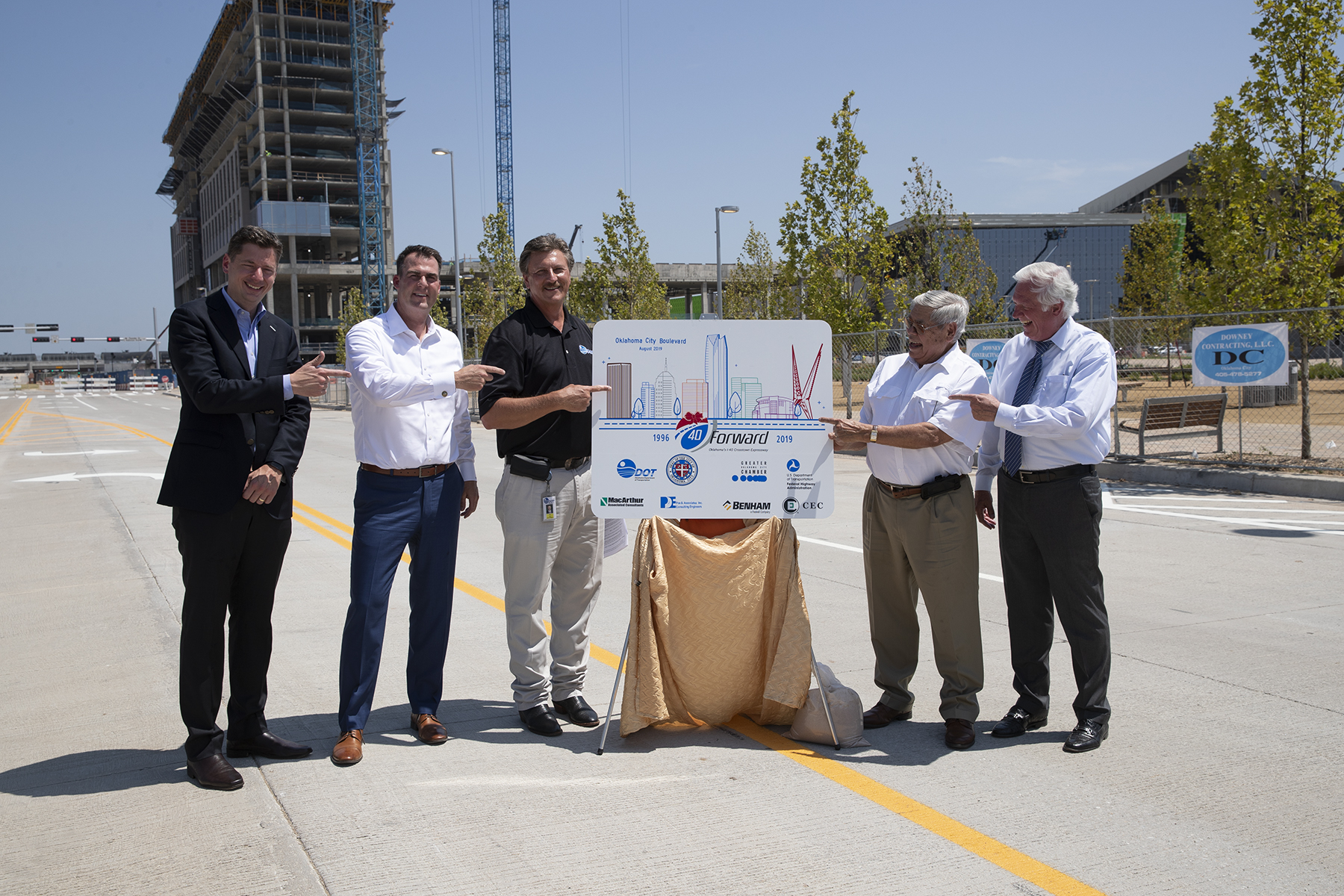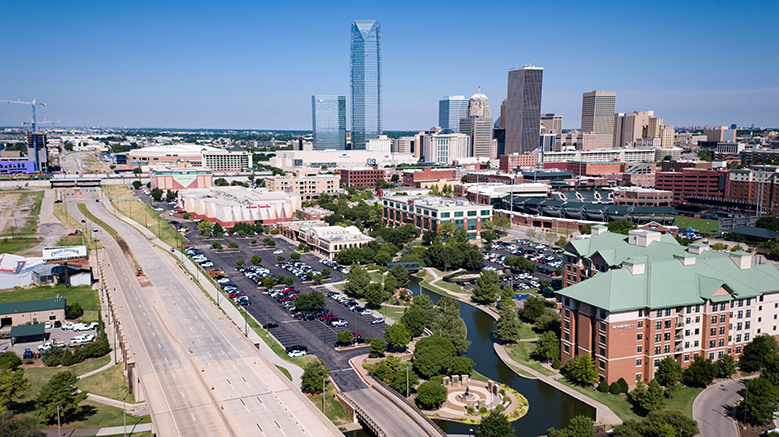From I-40 Crosstown to Oklahoma City Boulevard: State hands key for new downtown gateway to Oklahoma
***ACCESS an electronic press kit for this event at https://www.odot.org/newsmedia/press/2019/OKCBLVD
The Aug. 19 dedication by local and state leaders of the new Oklahoma City Boulevard closed the final chapter on the I-40 Crosstown rebuild, a nearly 25-year and $730 million federal and state infrastructure investment that transformed development opportunities in Oklahoma City’s downtown.
The final phase of the overall I-40 Crosstown reconstruction is the Oklahoma City Boulevard, which was opened today from E.K. Gaylord Blvd./Shields Blvd. to just east of Klein Ave. This final $27 million segment, completed within a year and a half, built the middle core sections of the new city street opens access to motorists from just west of Pennsylvania Ave. and the Dallas Junction of I-35/I-235. Drivers are cautioned that there will be temporary lane closures through September to complete final work needed on street lighting, traffic signals and landscaping.
After a rousing welcome to the event Monday by the OKC Thunder Drumline and Greater Oklahoma City Chamber of Commerce President and CEO Roy Williams, Gov. Kevin Stitt and Secretary of Transportation and Oklahoma Department of Transportation Executive Director Tim Gatz handed over the key for the new downtown gateway to Oklahoma City Mayor David Holt. Former Secretary of Transportation Neal McCaleb recalled the beginning of this historic project for the hundreds gathered to celebrate the official street opening.
“While this all started as an interstate reconstruction and safety project, it continues to open many doors for change in our capital city,” Gov. Stitt said. “Few cities of this size have the ability to literally start from the ground up with new boundaries for growing businesses and tourism. This project is a great example of the community working with the state to thoughtfully plan out their growth for decades to come.”
This project’s origin story dates back several decades and is rooted in the old I-40 Crosstown rebuild. When a crack was discovered in a bridge pier beam in 1989, it started a decades-long effort to replace the 4-mile-long bridge, which at the time was the state’s longest structurally deficient bridge. Out of lengthy discussions with the city and the Federal Highway Administration, along with numerous public input sessions, a state-of-the-art, modern interstate was designed to safely carry higher traffic volumes and serve as a gateway to downtown Oklahoma City.
The project transformed into a complete relocation of I-40 five blocks south of the old alignment in order to improve the safety of the corridor. This then pushed the downtown boundary south and paved the way for the old elevated bridge alignment to morph into a ground-level, four-lane city street with connections to surrounding interstates. Mainline I-40 Crosstown opened to traffic in 2012 and the estimated $120 million five phases of boulevard construction brings the total reconstruction project to about $730 million.
“The decades of public involvement for the I-40 Crosstown relocation including the Oklahoma City Boulevard has shown the citizens’ and city’s passion for being a part of the process and helping decide what will be best for the future,” Secretary of Transportation Gatz said. “The lines on our plans can’t convey the sheer magnitude of these two projects and its impacts to a community and we are so grateful that people took the time to be involved and make their voices heard.”
The new infrastructure has spurred development such as the new Oklahoma City Streetcar, a convention center, hotels and the upcoming Scissortail Park, which will open in late September, among other city and private projects.
“The completion of the Boulevard has been decades in the making and we’re excited to see its potential play out in the decades ahead,” Mayor Holt said. “The Boulevard will be a major point of entry to downtown and it ties together Scissortail Park, Chesapeake Arena, the Omni Hotel and the MAPS 3 convention center. It will be the anchor for countless business, housing and retail opportunities in the years ahead. This represents the end of the I-40 Crosstown story, but it is the start of a new story we’re anxious to experience.”
Once all items are complete in late September, the roadway will be turned over to the City of Oklahoma City to maintain and operate. Additionally, the city will be completing the landscaping portion of the project starting in September.
“The opening of the Oklahoma City Boulevard is the final stage of the successful I-40 Crosstown relocation —an initiative I have long championed and made possible in multiple national infrastructure bills,” Inhofe said. “This is a vital interstate corridor that will facilitate new connections to downtown Oklahoma City and relieve commuter traffic congestion. State, local and federal partners have worked together to keep this project on track, and I am pleased to see it completed today.”
The Greater Oklahoma City Chamber of Commerce was one of the early supporters of the I-40 Crosstown reconstruction and the Oklahoma City Boulevard because of its business significance. “A good, reliable transportation system is critical to the business climate of our state and this project is vitally important to accessing downtown Oklahoma City,” Williams said.
Additionally, to commemorate their involvement, consultants and prime contractors involved throughout the years in this benchmark project contributed to the opening celebration with giveaways including T-shirts, a medallion and keepsake signs that mirror a larger highway sign presented to Holt by Gatz and Stitt. Consulting companies included in this effort are MacArthur Associated Consultants, Poe and Associates, Benham, CEC and contractors included Allen Contracting Inc., Duit Holdings Inc., Manhattan Road and Bridge and Sherwood Construction Co. Inc.

A key to the new Oklahoma City Boulevard was presented Aug. 19 to Oklahoma City Mayor David Holt, center holding key, by state representatives including, from left, former secretaries of transportation Mike Patterson, Gary Ridley and Neal McCaleb, Gov. Kevin Stitt, Secretary of Transportation Tim Gatz. There were joined by Greater Oklahoma City Chamber of Commerce President and CEO Roy Williams.

The Oklahoma Department of Transportation presented Oklahoma City Mayor David Holt, left, with a sign depicting the downtown Oklahoma City skyline to commemorate the opening of the new Oklahoma City Boulevard on Aug. 19. Also pictured are, from left after Holt, Gov. Kevin Stitt, Secretary of Transportation Tim Gatz, former Secretary of Transportation Neal McCaleb and Greater Oklahoma City Chamber of Commerce President and CEO Roy Williams.

This aerial view of the Oklahoma City Boulevard looks toward the west from the Dallas Junction ramps on the east end of the new city street.


